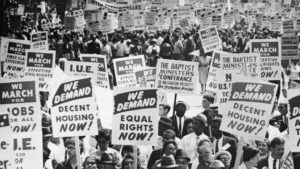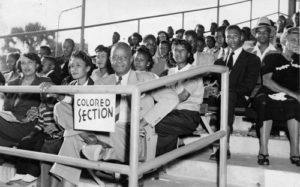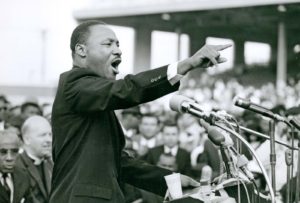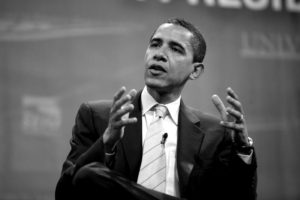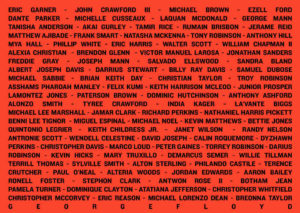A Brief Timeline of the Civil Rights Movement
A Brief Timeline of the Civil Rights Movement
The Civil Rights Movement of the 1950’s and 1960’s was one of the most influential periods in American History. Even with the signing of the Emancipation Proclamation in 1863, African Americans would continue to be the victims of racial segregation, disenfranchisement, exploitation, and violence for nearly a century to follow. With the 1896 ruling of Plessy v. Ferguson, justifying “separate but equal,” treatment for African Americans, most public facilities such as bathrooms, “colored balconies,” water fountains, buses, sports, and schools remained segregated. Many efforts were made to combat this oppression, such as the formation of the NAACP (National Association for the Advancement of Colored People) in 1909, however, it took more than just litigation, education, and lobbying efforts to create all the social reforms that were necessary for change.
It wasn’t until the 1950’s, starting with the landmark case of Brown v. Board of Education, and the overruling of “separate but equal” established 58 years prior, that the civil rights movement began to take off. Through numerous organizations, boycotts, “sit-ins,” marches, federal legislation, and influential individual leaders that political legislation and social accommodations were finally starting to become a reality.
One of the most remarkable features of this movement was its relatively minimal bloodshed. Though hundreds of deaths and injuries occurred, compared to the civil war, which resulted in the deaths of 620,000 soldiers and an undetermined number of civilian casualties, the Civil Rights Movement brought about social reform without nearly as much loss as past American wars or revolutions.
Though some influential leaders of the movement, such as Malcolm X, believed a civil rights revolution was not possible without using violence, others such as Dr. Martin Luther King Jr., used a method of nonviolent resistance, also known as civil disobedience, to protest African American oppression. Modeling the approach used by Gandhi while protesting the British rule in India, Dr. King believed that civil disobedience could be used as “a potent instrument for social and collective transformation. (It is) through our pain we will make them (white society) see their injustice”. To Dr. King, “Nonviolence became more than a method to which I gave intellectual assent; it became a commitment to a way of life.”
But even though the Civil Rights Movement brought American society closer to equal rights and treatment, we still have a long way to go. In the words of Archie Loss, Professor of American Studies and Popular Culture at Penn State Behrend, “We would not have the President now occupying the White House if it weren’t for the sacrifices and tenacity of the people involved in the Movement then. At the same time, it’s naive to think that racism is dead in our society. It isn’t dead, it’s just disguised itself in other forms. Certainly, there have been enormous gains for African-Americans, but there are also many hurdles still to be cleared, especially for those in the lower economic brackets. And demographically African-Americans still attend lesser schools in certain areas rather than better ones.”
Dr. Loss is right. Many people of his generation never thought they’d live to see the day a black president would hold the office, yet as recently as October 17th, 2009, Keith Bardwell, a Louisiana justice of the peace, refused to marry an interracial couple because in his experience, most interracial marriages did not succeed.
Indeed, though we have made progress, we still have a far way to go. For example, it was only a week ago, on October 28th, 2009, that President Barack Obama signed into law by the Matthew Shepard Act which expands the 1969 U.S. federal hate-crime law to include crimes motivated by a victim’s actual or perceived gender, sexual orientation, gender identity, or disability.
Though we’ve made many great strides in the effort for racial equality, much work still needs to be done. In the words of LBJ, “Until justice is blind to color, until education is unaware of race, until opportunity is unconcerned with the color of men’s skins, emancipation will be a proclamation but not a fact.”
TIMELINE
•In 1954, Brown v. Board of Education overturned the 1896 ruling of Plessy v. Ferguson and made the policy of “separate but equal” unconstitutional. The decision was based on a violation of the Equal Protection Clause of the Fourteenth Amendment of the U.S. Constitution.
•In August of 1955, Emmitt Till was murdered while visiting Mississippi by two white men, J. W. Milam and Roy Bryant, who were acquitted by an all white jury. Later the men bragged about the murder in a magazine interview.
•On December 1, 1955, in Montgomery, Alabama, Rosa Parks refused to give up her seat and move to the “colored section,” in the back of the bus. The incident inspired a yearlong boycott by the black community, largely orchestrated by Reverend Dr. Martin Luther King Jr., until on December 21, 1956, the buses of were desegregated. In the words of Rosa Parks, “At the time I was arrested I had no idea it would turn into this. It was just a day like any other day. The only thing that made it significant was the masses of the people joined in.”
•In January of 1957, Martin Luther King Jr. was named president of the Southern Christian Leadership Conference (SCLC). The group utilized many same techniques used by Gandhi against the British. The values of non-violence, passive resistance, and civil disobedience were as forms of protest.
•Also in 1957, Arkansas governor Orval Faubus denied nine black students entrance in a local school. These nine students were later coined “The Little Rock Nine.” The National Guard and other federal troops had to be called in to allow the students to enter.
•In 1960, four students from Greensboro, North Carolina, began the first “sit-in.” The event took place in a segregated cafeteria, and though the students were not served food, they were not forced to move. This was the first of many “sit-ins” that became an integral part of the civil rights movement. Also in this year, SNCC, the Student Nonviolent Coordinating Committee, was formed.
•In 1961, “Freedom Riders,” over 1,000 volunteer students both black and white, rode into the South to investigate continuing discrimination in the public transportation system. Some of theses “Freedom Riders” were physically and verbally attacked as they traveled.
•On October 1, 1962, the first black student was admitted to the University of Mississippi. Riots occurred and John F. Kennedy was forced to send in 5,000 troops to aid in handling the situation.
•On July 23, 1962, Jackie Robinson became the first African American to be inducted into the Baseball Hall of Fame. Major League baseball was completely segregated until 1946 when Jackie Robinson was also the first player to break the color barrier.
•On April 16, 1963, Martin Luther King wrote his famous “Letter from Birmingham Jail” in which he argues that individuals have a duty to disobey unjust laws. In the words of MLK, “Injustice anywhere is a threat to justice everywhere.”
•In May 1963, black protesters from Birmingham were shown being sprayed by fire hoses by policemen on national news media. This shocking and brutal image helped the Civil Rights Movement gain support among white Americans who could no longer remain ignorant to the cruel mistreatment of African Americans in the South.
•On June 12, 1963, Medgar Evers, a NAACP field secretary, was shot outside his home. The alleged perpetrator, Byron De La Beckwith was tried twice, but not convicted until 30 years later. This incident inspired Bob Dylan’s song, “Only a Pawn in their Game,” one of his many famous protest songs adopted by the civil rights and counterculture movements.
•On August 28, 1963, the “March on Washington” is held at the Lincoln Memorial. 200,000 people are there to hear Martin Luther King’s “I Have a Dream,” speech. “I have a dream that one day this nation will rise up and live out the true meaning of its creed: ‘We hold these truths to be self-evident, that all men are created equal. I have a dream that my four little children will one day live in a nation where they will not be judged by the color of their skin, but by the content of their character.”
•On September 15, 1963, four girls were killed when a bomb exploded at the 16th Street Bridge Baptist Church. The location was a popular meeting place for civil rights meetings. The girls were attending Sunday school at the time of their death. The incident leads to riots in Birmingham where two more black men were killed.
•On January 23, 1964, the poll tax was abolished by the 24th Amendment. The poll tax was a fee to vote that was a law in 11 Southern states that made it difficult for poor, black citizens to vote.
•In the summer of 1964, CORE, the Congress of Racial Equality, joined up with SNCC in a collaborative effort to register black voters. The movement was known as the Freedom Summer. This movement brought national attention for the voting rights of black citizens and eventually led to the Voting Rights Act of 1965.
•On July 2, 1964, the Civil Rights Act is signed by LBJ. Though initially proposed by Kennedy, LBJ was from the South and used his connections with Southern Democrats to get the bill through Congress. The Civil Rights Act was a comprehensive law that prohibits discrimination, not only based on one’s race, but religion and origin as well.
•On August 4, 1964, three male civil rights activists, two white and one black, were arrested and then released to the KKK who murdered them.
•On December 10, 1964, Dr. Martin Luther King, Jr. was awarded the Nobel Peace Prize. At 35 years old, MLK was the youngest man to receive the award. King donated the $54,123 in prize money to the furtherance of the Civil Rights Movement.
•March 7, 1964, became known as “Bloody Sunday” after 50 protesters were hospitalized when police used tear gas and billy clubs against them. This event was also a major factor in getting the voting rights act passed.
•On February 21, 1965 Malcolm X was murdered. Malcolm X was an influential civil rights leader who promoted Black Nationalism and was not against violence as a means of revolution. In the words of Malcolm X, “You can’t separate peace from freedom because no one can be at peace unless he has his freedom.”
•On August 10, 1965 the Voting Rights Act was passed which prohibited literacy tests, poll taxes, or property ownership to be a requirement for black voters in the South.
•On August 11th through the 16th, the Watts riots left 34 dead in Los Angeles. Only after the National Guard sent in 14,000 soldiers to assist the already 1,500 police officers on duty did peace return to Watts. All in all, 35 million dollars worth of damages occurred.
•On September 24, 1965, LBJ enforced the first acts of Affirmative Action, prohibiting employers from discrimination in hiring.
•In October of 1966, The Black Panther Party was founded and adopts many of the values of Malcolm X. The movement had “provocative rhetoric and militant posture.” A ten-point list of demands was created that members strived for and promoted.
•On April 19, 1967, Stokely Carmichael, leader of SNCC, coined the phrase “black power.” He defined black power as “the coming together of black people to fight for their liberation by any means necessary.” This assertion alarmed many people who believed that non-violence, passive resistance, and civil disobedience were the best means to achieve equal civil rights.
•On June 12, 1967, the case of Loving v. Virginia set the precedence that not allowing interracial marriages was unconstitutional. 16 states were forced to comply.
•From July 12th through the 16th, 1967, race riots took place in Newark, New Jersey, and from July 23 through the 30th race riots occurred in Detroit.
•On April 4, 1968, Martin Luther King was shot by James Earl Ray while on his balcony outside his hotel room in Memphis, Tennessee. Riots erupted all over the country, primarily in black urban areas. At least 110 cities experienced violence and destruction in the next few days, resulting in roughly $50 million in damage. Of the 39 people who died, 34 were black. The worst riots were in Chicago, Baltimore and Washington, D.C. Over 22,000 federal troops and 34,000 National Guard were sent to aid local police.
•On April 11, 1968 President Johnson signed the Civil Rights Act of 1968 barring discrimination in housing, sales, and retail.
•Also in 1968, Arthur Ashe became the first African American tennis player to win the U.S. Open.
•In 1969, the executive director of the Seattle Urban League, Edwin Pratt, a civil rights activist, was shot while at this home. His murder has never been solved.
•Also during this time, protests against American involvement in the Vietnam War were at an all time high. The subjectivity of the composition of the ground forces (the fact that American soldiers who were enlisted or drafted were disproportionately African American or lower-class citizens) was a major argument used by “Doves” who were against the war. Riots erupted at the Democratic National Convention in Chicago, largely in part because of the recent deaths of MLK and Bobby Kennedy.
•In 1972, Shirley Chisholm runs for President when the Civil Rights Movements combines with the rise of the feminist movement. Chisholm said “I’ve always met more discrimination being a woman than being Black”. While she didn’t win the election, she stands as the first female candidate for president as well as the first African-American primary candidate.
•In 1973, the National Black Feminist Organization is formed, with one of the founders declaring that “there can’t be liberation for half of a race.”
•June of 1978, the Bakke vs. Regents of University of California decided that the use of strict racial quotas for higher education was unconstitutional, but also allowed race to be rightfully used as criterion for admissions decisions for diversity reasons.
•During 1983, Harold Washington, was elected as the first Black Mayor of Chicago.
•In 1986, Oprah Winfrey begins her own show which would eventually go on to be the highest rated in TV history. She later became the first female African-American billionaire.
•March 1991, Rodney King is pulled over the highway patrol in Los Angeles and leads them to a high speed chase. LAPD officers finally caught up with him, tasing him and beating him. As it was filmed and then seen by millions across the country, the officers in question were tried and eventually found not guilty. This decision sparked the four-day LA Riots. Two of the officers were re-tried and convicted in a federal court.
•In October of 1995, Minister Louis Farrakhan leads the Million Man March in Washington, D.C., in peaceful protest of the War on Drugs and the disproportionate number of black individuals who were arrested.
•Inspired by the success of the Million Man March of 1995, in 1997, the Million Woman March took place in Philadelphia.
•By 2000, more black men were incarcerated than were in college.
•In 2001, George W. Bush appoints Collin Powell to Secretary of State, making him the first Black man to be America’s top diplomat. He would later resign after Bush’s reelection in 2004. Following this, Bush would appoint Condoleezza Rice to the same position, making her first female African-American Secretary of State.
•Barack Obama becomes the first African-American President on January 20th, 2009. He would be reelected in 2012.
•February 26th, 2012, George Zimmerman of Florida, shoots and kills the unarmed Trayvon Martin. His death triggers nationwide protests.
•In July of 2013, the term “Black Lives Matter” would first be used in a Facebook post by Alicia Garza in response to the clearing of George Zimmerman. The Black Lives Matter Network would be founded in the same year by Patrisse Cullors, Garza, and Opal Temeti.
•March 2nd, 2014, Gabriella Neverez was shot and killed by Citrus Heights PD after they pulled her over at which time she supposedly slammed into the police cruiser, triggering them to fire 17 shots into the car.
•July 17th, 2014, Eric Garner is killed by Daniel Panteleo, an NYPD officer, on Staten Island after being put in a chokehold (which had been banned in the NYPD since 1993).
•August 5th, 2014, John Crawford III is shot and killed by a police officer in an Ohio Walmart for holding a BB gun that was for sale in the store.
•August 9th, 2014, Michael Brown is shot and killed by Daren Wilson, and officer Ferguson, Missouri.
•August 14th, 2014, Michelle Cusseaux is shot and killed by Sargent Percy Dupra of Phoenix PD after police arrived to serve a mental health pickup.
•November 9th, 2014, Aura Rosser is shot and killed by Ann Arbor officer David Ried when he responded to a 911 call from the same apartment.
•November 13th, 2014, Tanisha Anderson was killed by Cleveland officers Scott Aldridge and Brian Meyers after responding to a mental health call. Within 30 minutes of taking her, she was handcuffed, prone on the ground not breathing.
•November 20th, 2014, Akai Gurley is shot and killed by Peter Liang of the NYPD when a fired bullet ricocheted in a stairwell that Gurley was walking down.
•November 22nd, 2014, Tamir Rice, a 12-year old boy holding a replica toy gun is shot and killed by Timothy Loehmann of the of the Cleveland PD.
•February 18th, 2015, Janisha Fonville is shot and killed by Anthony Holzhauer of the Charlotte-Mecklenburg PD after responding to a mental health pickup.
•April 4th, 2015, Walter Scott is shot and killed by Michael Slager of the North Charleston PD after being pulled over for a non-functioning brake light.
•April 22, 2015, Freddie Carlos Gray Jr. is arrested by Baltimore PD for possession of a knife and dies while being transported in a Police van after having fallen into a coma from inflicted injuries to his spinal cord.
•November 15th, 2015, Jamar Clark is shot and killed by Minneapolis PD when paramedics ask Clark to step away from the ambulance which his girlfriend was in. Disputed accounts say that he was handcuffed and calm before being shot while others say he was resisting arrest and uncuffed.
•July 5th, 2016, Alton Sterling is shot and killed by Baton Rouge PD officer Blane Salmamoni who confronted him outside a shop. The encounter was captured on camera.
•July 6th, 2016, Philando Castile is shot and killed Jeronimo Yanez of St. Anthony Minnesota PD after being pulled over and informing Yanez that he did have a firearm that he was licensed to carry. Yanez told him not to reach for the weapon and though Castile didn’t and told him he wouldn’t was shot at close range five times. The encounter was captured on camera.
•March 18th, 2018, Stephon Clark is shot and killed by Terrance Mercadal and Jared Robinet of Sacremento PD while he stood in his grandmother’s backyard holding a cellphone.
•June 19th, 2018, Antwon Rose Jr. is shot and killed by Michael Rosfield of the East Pittsburgh PD after being involved in a drive-by shooting and running from him, unarmed.
•July 19th, 2018, Markeis McGlockton is shot and killed by Michael Drejka in a parking lot after an argument about a parking space McGlockton’s girlfriend was parked in.
•September 6th, 2018, Botham Jean is shot and killed in his own apartment by off-duty Dallas police officer Amber Guyger, who believed she had walked into her own apartment, thinking him a burglar.
•November 22nd, 2018, Emantic Fitzgerald Bradford Jr. was shot and killed by officers of the Hoover, Alabama PD when they wrongfully believed him to be the active shooter at a shopping mall in town.
•October 12th, 2019, Atiana Jefferson is shot and killed by Fort Worth PD after they responded to a non-emergency call about her front door being open.
•February 23, 2020, Ahmaud Marquez Arbery is shot and killed while on a jog near his home by locals Travis McMichael and Gregory McMichael who chased him down in a truck.
•March 13th, 2020, Breonna Taylor is shot and killed Louisville Metro PD after entering her home with a no-knock warrant. Her boyfriend, believing it was a break in, fired at the plainclothes officers. Taylor was unarmed and shot by officers 8 times.
•May 25th, 2020, George Floyd is killed while Minneapolis PD officer Derek Chauvin kneels on his neck for 8 minutes and 46 seconds after accusing him of using a counterfeit $20 bill.
•May 26th, 2020, the day after the murder of George Floyd, people from every state in the country take to streets to protest the systematic racism in America and reinvigorate the “Black Lives Matter” movement, sparking similar movements across the world.
Black Lives Matter.
Citations:
A & E Television Networks. (2009). Jackie robinson biography . Retrieved from http://www.biography.com/articles/Jackie-Robinson-9460813?part=2
African american world. Retrieved from http://www.pbs.org/wnet/aaworld/timeline/civil_01.html
Answers Corporation, (2006). Watts riots. Retrieved from http://www.answers.com/topic/watts-riots#
BrainyMedia.com, (2009). Brainyquote. Retrieved from http://www.brainyquote.com/quotes/authors/r/rosa_parks.html#
Brunner, B., & Haney, E. (2009). Civil rights timeline. Retrieved from http://www.infoplease.com/spot/civilrightstimeline1.html
CORE, (2006). Three core members murdered in mississippi. Retrieved from http://www.core- online.org/History/freedom_summer.html
Curtis, (2006). Life of a party. Crisis, 113(5),
D’Souza, P.P. (2003, January 20). Commemorating martin luther king jr. Retrieved from http://www.sfgate.com/cgibin/article.cgi?file=/chronicle/archive/2003/01/20/ED16367 3.DTL
History.com Editors. (2009, October 14). Black History Milestones: Timeline. Retrieved June 27, 2020, from https://www.history.com/topics/black-history/black-history-milestones
Jazeera, A. (2020). Know their names: Black people killed by the police in the US. Retrieved June 27, 2020, from https://interactive.aljazeera.com/aje/2020/know-their-names/index.html
Loss, Archie. (personal communication, November 2, 2009).
McPherson, J. (2009). An Overview of the american civil war. Retrieved from http://www.civilwar.org/education/history/civil-war-overview/overview.html
Moncur, M. (2007). Quotations by author. Retrieved from http://www.quotationspage.com/quotes/Malcolm_X/
National archives and records administration. Retrieved from http://www.archives.gov/exhibits/featured_documents/emancipation_proclamation/
The Nobel Foundation, (2009). Martin luther king jr. Retrieved from http://nobelprize.org/nobel_prizes/peace/laureates/1964/king-bio.html
https://www.npr.org/2020/05/29/865261916/a-decade-of-watching-black-people-die
Simkin, J. Martin luther king: biography. Retrieved from
Martin Luther King
Six years of the student nonviolent coordinating committee. Retrieved from http://www.ibiblio.org/sncc/
Sweeney, N. (2009, October 30). Civil rights history. Retrieved from http://www.civilrights.org/resources/
(1997). The Civil rights struggle in modern times. Retrieved from http://www.cnn.com/EVENTS/1997/mlk/links.html
(2003). Black american history. Retrieved from http://www.africanaonline.com/civil_rights_timeline.htm
(2006). Congress of racial equality. African american world. Retrieved from http://www.pbs.org/wnet/aaworld/timeline/civil_01.html
(2009, October 30). African american civil rights movement (1955- 1968). Retrieved from http://en.wikipedia.org/wiki/African- American_Civil_Rights_Movement_(1955%E2%80%931968)
(2009). Civil rights. Retrieved from http://www.whitehouse.gov/issues/civil-rights/
(2009). National assocation for the advancement of colored people. Retrieved from http://www.naacp.org/home/index.htm
(2009). New georgia encyclopedia. Retrieved from http://www.georgiaencyclopedia.org/nge/Article.jsp?id=h-2716
(2009). Southern christian leadership conference. Retrieved from http://www.sclcnational.org/#
Image Source: https://www.npr.org/2014/04/04/299063588/the-politics-of-passing-1964s-civil-rights-act

